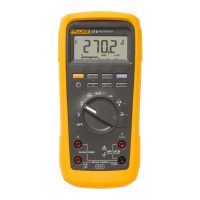Maintenance
Introduction
3
3-3
XWWarning
To avoid electric shock or personal injury:
• Do not perform any servicing other than operator
maintenance unless you are qualified to do so. These
service instructions are for used by qualified personnel
only.
• Do not allow water to get inside case.
• Remove any input signals prior to removing test leads and
opening case.
• When servicing the meter, use only specified replacement
parts.
• Make sure the battery door is closed and latched before you
operate the meter.
• To prevent arc blast and resulting injury, install only
specified replacement fuses with the speed, amperage,
interrupt rating and voltage rating listed in Fuse
Replacement section.
3-1. Introduction
This chapter presents instructions for disassembly, performance tests, calibration
adjustment, and troubleshooting. The performance tests may be used as an acceptance
test when the instrument is first received, and can be used later as a preventive
maintenance tool.
A l-year calibration cycle is recommended to maintain the instrument’s specifications. In
addition, the seals should be replaced during servicing to maintain the environmental
specifications stated in that manual. A seal kit is available from the factory. The seal kit
(Model 8025A-740 1, part number 738112) contains a complete set of seals and four
replacement screws and washers for the bottom case.
The test equipment required for the performance tests and calibration adjustments is
listed in Table 3-1. Test equipment with equivalent specifications may be used if the
recommended models are unavailable.
Table 3-1. Recommended Test Equipment
Instrument Type Required Characteristics Recommended Model
Voltage Range: 0-1000 V ac, ±.05%
Frequency Range: 40 - 10,000 Hz, ±1%
DMM Calibrator Voltage Range: 0-1000 V dc
Accuracy: ±.05%
Fluke Model 5500A
Current Range: 2 mA - 5 A
Accuracy: ±.2%
Values: 100 ohm, 1 kilohm, 10 kilohm, 100
kilohm, 1 megohm, 10 megohm
Accuracy±.06%

